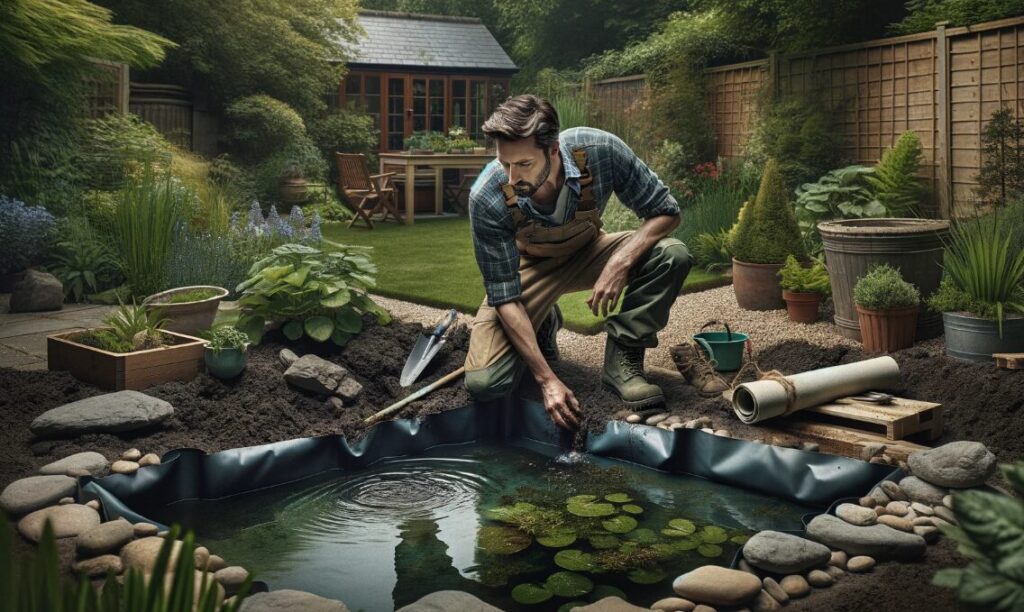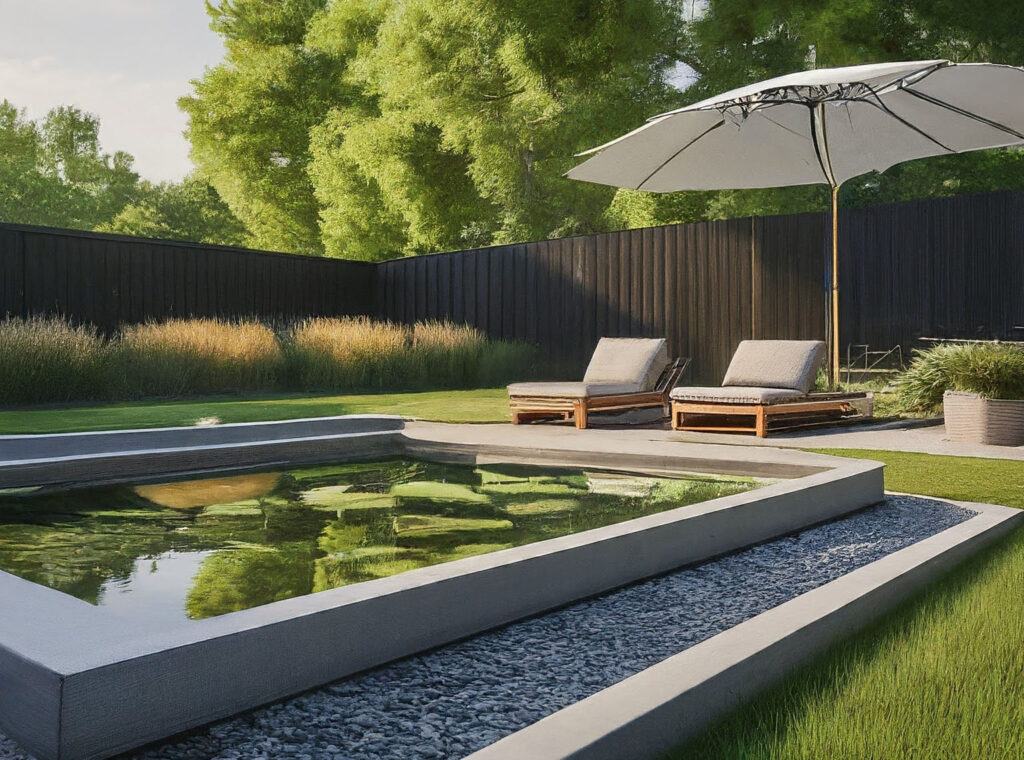A backyard pond can transform an ordinary outdoor space into a tranquil oasis, a place where you can unwind, entertain, and reconnect with nature. The ripple of water, the flash of fish in the sun, and the play of light on the surface can add a serene beauty to your home. For DIY enthusiasts, the process of creating a pond from scratch is not just a project but a journey into crafting your own piece of paradise. It’s about rolling up your sleeves, digging in, and creating something that brings joy and tranquility to your backyard.

Planning Your Pond
Before diving into the build, a bit of groundwork (pun intended) is necessary. Here’s how you lay the foundation for a successful pond project:
- Deciding on the Location. Your pond’s location is crucial. Look for a spot that gets a mix of sunlight and shade throughout the day. Too much sun and you might battle algae, too little, and your aquatic plants might not thrive. Consider the proximity to trees, while a picturesque backdrop, falling leaves can become a maintenance headache.
- Determining the Size and Depth. Think about what you want from your pond. Is it for koi, a water garden, or perhaps just the sound and sight of water? A deeper pond is needed for fish to overwinter successfully, while a shallow one might suffice for a simple water feature.
- Selecting the Type of Pond. Whether it’s a fish pond, water garden, or a reflective pool, your choice will dictate the design, filtration, and wildlife you can support. Each has its charm and requirements.
- Required Tools and Materials. Arm yourself with the essentials. You’ll need shovels for digging, a pond liner, underlayment to protect your liner, a filtration system, and possibly a pump for water movement. Don’t skimp on quality here, these are the bones of your backyard oasis.

Design Ideas and Inspiration
With a plan in hand, it’s time to get creative:
- Incorporating Landscaping Elements. Use rocks, aquatic plants, and perhaps a waterfall or backyard fountain to create a naturalistic setting. These elements are not just decorative, they play a role in the pond’s ecosystem.
- Creative Ideas for Every Size and Budget. From container water gardens for petite spaces to grand, sweeping ponds, there’s a solution for every yard. Recycled materials can be repurposed into unique features, keeping costs down without compromising on style.
- Tips for Creating a Natural Look and Feel. Aim for asymmetry in your design for a more natural appearance. Use varying sizes of stones and plant groupings to mimic nature. The goal is to make it look like your pond has always been there.

The Construction Process
Now, for the meat of the project—construction. Here’s a step-by-step rundown:
- Excavating. Mark out your pond’s shape and start digging. Your depth will vary based on your pond’s purpose, but remember to slope the sides gently to create shelves for plants.
- Lining. Once dug, line your pond with a quality underlayment before laying the pond liner over it. This protects against punctures and ensures your pond holds water.
- Filling. Begin filling your pond with water. As it fills, adjust the liner to remove wrinkles and folds, ensuring a smooth surface.
- Installing Filtration and Aeration. A good filtration system keeps the water clear, while aeration is vital for fish health. Choose a filter appropriate for your pond’s volume and stock it with the right pump for circulation.
- Adding Plants and Fish. Select plants that fit your pond’s environment—floating, submerged, and marginal. When introducing fish, acclimate them to the water temperature and start with a few, so the pond’s ecosystem can adjust.

Maintenance and Care
Keeping your backyard pond in tip-top shape is not just about preserving its beauty, it’s about ensuring the health and longevity of the aquatic life and plants it supports. Here’s how to keep your pond crystal clear and the inhabitants happy:
- Routine Upkeep Tasks. Like any part of your home, a pond needs regular maintenance. Skimming off leaves and debris, checking and cleaning filters, and monitoring water levels should be part of your weekly routine. Feeding fish should be done with care, following the “less is more” principle to avoid overfeeding and the water quality issues that can follow.
- Winter Preparation. If you’re in a frosty locale, winterizing your pond is crucial. This might mean installing a pond heater or aerator to keep the surface from completely freezing over, allowing harmful gases to escape. Also, consider moving delicate plants indoors or to a frost-free area.
- Troubleshooting Common Pond Issues. Algae blooms can turn your pond into pea soup in no time. Regularly cleaning your pond and maintaining a balanced plant life can keep algae in check. For leaks, inspect the liner for punctures or tears. Water clarity issues can often be resolved with a good filtration system and reducing fish population if overstocked.

Safety Considerations
Creating a safe environment around your pond is paramount, especially if you have kids or pets:
- Ensuring a Safe Environment. It starts with design. Gentle slopes and shallow areas not only make for a more naturalistic look but also reduce risk. Installing fencing or a rigid pond cover can add an extra layer of safety for young children.
- Child-proofing and Wildlife Considerations. Beyond the immediate safety measures, think about accessibility. A barrier that keeps children out but allows wildlife to access can contribute to both safety and the ecological balance of your garden.
FAQ Section
The cost can vary widely depending on size, materials, and whether you do it yourself or hire some muscle. A simple, small pond can be built for a few hundred bucks, while larger, more elaborate projects can run into the thousands.
Absolutely, with a bit of muscle and patience, building a backyard pond is a feasible project for a DIY enthusiast. Detailed planning and a clear understanding of the steps involved are crucial.
A balanced ecosystem is key. This means having the right mix of plants, fish, aeration, and a good filtration system. Regular maintenance, such as debris removal and filter cleaning, will keep your pond in good health.
Koi and goldfish are the go-to for many pond owners due to their hardiness and beauty. However, make sure your pond is suitable for the fish you choose in terms of size, depth, and water conditions.
Start by removing any debris and cutting back plants. Install a pond heater or aerator to keep a section of the pond surface ice-free. Consider moving fish and tender plants to a safe location if extreme cold is expected.
This can vary by location. In many cases, small ponds may not require a permit, but it’s always best to check with your local building department or zoning office to avoid any surprises.
